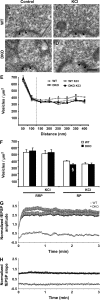Synapsin- and actin-dependent frequency enhancement in mouse hippocampal mossy fiber synapses
- PMID: 18550596
- PMCID: PMC2638812
- DOI: 10.1093/cercor/bhn101
Synapsin- and actin-dependent frequency enhancement in mouse hippocampal mossy fiber synapses
Abstract
The synapsin proteins have different roles in excitatory and inhibitory synaptic terminals. We demonstrate a differential role between types of excitatory terminals. Structural and functional aspects of the hippocampal mossy fiber (MF) synapses were studied in wild-type (WT) mice and in synapsin double-knockout mice (DKO). A severe reduction in the number of synaptic vesicles situated more than 100 nm away from the presynaptic membrane active zone was found in the synapsin DKO animals. The ultrastructural level gave concomitant reduction in F-actin immunoreactivity observed at the periactive endocytic zone of the MF terminals. Frequency facilitation was normal in synapsin DKO mice at low firing rates (approximately 0.1 Hz) but was impaired at firing rates within the physiological range (approximately 2 Hz). Synapses made by associational/commissural fibers showed comparatively small frequency facilitation at the same frequencies. Synapsin-dependent facilitation in MF synapses of WT mice was attenuated by blocking F-actin polymerization with cytochalasin B in hippocampal slices. Synapsin III, selectively seen in MF synapses, is enriched specifically in the area adjacent to the synaptic cleft. This may underlie the ability of synapsin III to promote synaptic depression, contributing to the reduced frequency facilitation observed in the absence of synapsins I and II.
Figures






Similar articles
-
The Lack of Synapsin Alters Presynaptic Plasticity at Hippocampal Mossy Fibers in Male Mice.eNeuro. 2024 Jul 3;11(7):ENEURO.0330-23.2024. doi: 10.1523/ENEURO.0330-23.2024. Print 2024 Jul. eNeuro. 2024. PMID: 38866497 Free PMC article.
-
Regulation of neurotransmitter release by synapsin III.J Neurosci. 2002 Jun 1;22(11):4372-80. doi: 10.1523/JNEUROSCI.22-11-04372.2002. J Neurosci. 2002. PMID: 12040043 Free PMC article.
-
ERK activation in axonal varicosities modulates presynaptic plasticity in the CA3 region of the hippocampus through synapsin I.Proc Natl Acad Sci U S A. 2009 Jun 16;106(24):9872-7. doi: 10.1073/pnas.0900077106. Epub 2009 Jun 1. Proc Natl Acad Sci U S A. 2009. PMID: 19487674 Free PMC article.
-
Glutamatergic neurotransmission in the synapsin I and II double knock-out mouse.Semin Cell Dev Biol. 2011 Jun;22(4):400-7. doi: 10.1016/j.semcdb.2011.07.004. Epub 2011 Jul 31. Semin Cell Dev Biol. 2011. PMID: 21827868 Review.
-
Synapsins: from synapse to network hyperexcitability and epilepsy.Semin Cell Dev Biol. 2011 Jun;22(4):408-15. doi: 10.1016/j.semcdb.2011.07.005. Epub 2011 Jul 26. Semin Cell Dev Biol. 2011. PMID: 21816229 Review.
Cited by
-
Control of Synapse Structure and Function by Actin and Its Regulators.Cells. 2022 Feb 9;11(4):603. doi: 10.3390/cells11040603. Cells. 2022. PMID: 35203254 Free PMC article. Review.
-
Lateral mobility of presynaptic L-type calcium channels at photoreceptor ribbon synapses.J Neurosci. 2011 Mar 23;31(12):4397-406. doi: 10.1523/JNEUROSCI.5921-10.2011. J Neurosci. 2011. PMID: 21430141 Free PMC article.
-
The rearrangement of actin cytoskeleton in mossy fiber synapses in a model of experimental febrile seizures.Front Neurol. 2023 Apr 20;14:1107538. doi: 10.3389/fneur.2023.1107538. eCollection 2023. Front Neurol. 2023. PMID: 37181554 Free PMC article.
-
An autoinhibitory clamp of actin assembly constrains and directs synaptic endocytosis.Elife. 2021 Jul 29;10:e69597. doi: 10.7554/eLife.69597. Elife. 2021. PMID: 34324418 Free PMC article.
-
Transgenic modeling of Ndr2 gene amplification reveals disturbance of hippocampus circuitry and function.iScience. 2021 Jul 19;24(8):102868. doi: 10.1016/j.isci.2021.102868. eCollection 2021 Aug 20. iScience. 2021. PMID: 34381982 Free PMC article.
References
-
- Ashton AC, Ushkaryov YA. Properties of synaptic vesicle pools in mature central nerve terminals. J Biol Chem. 2005;280:37278–37288. - PubMed
-
- Atwood HL, Karunanithi S. Diversification of synaptic strength: presynaptic elements. Nat Rev Neurosci. 2002;3:497–516. - PubMed
-
- Bahler M, Greengard P. Synapsin I bundles F-actin in a phosphorylation-dependent manner. Nature. 1987;326:704–707. - PubMed

